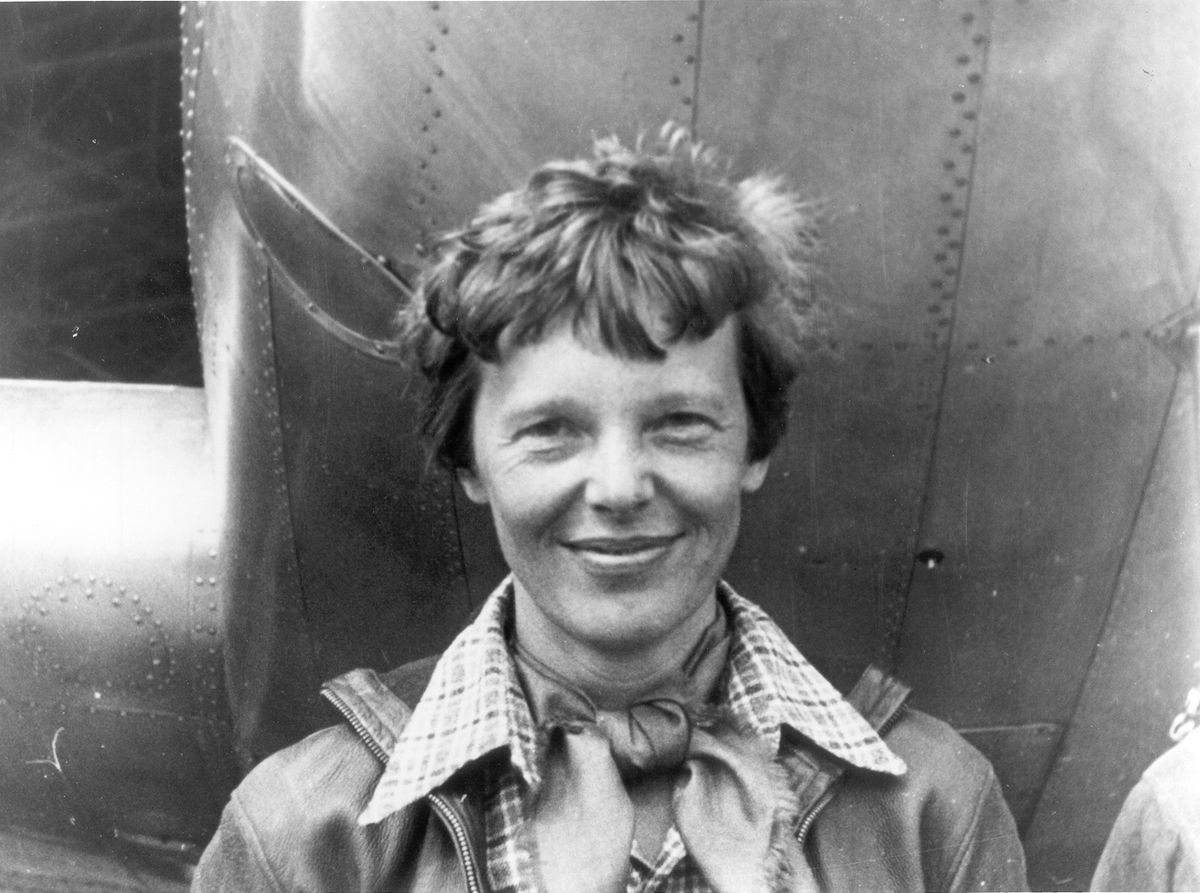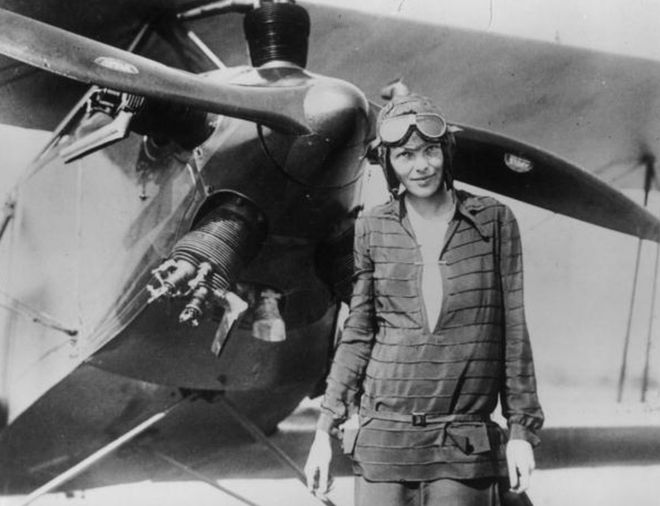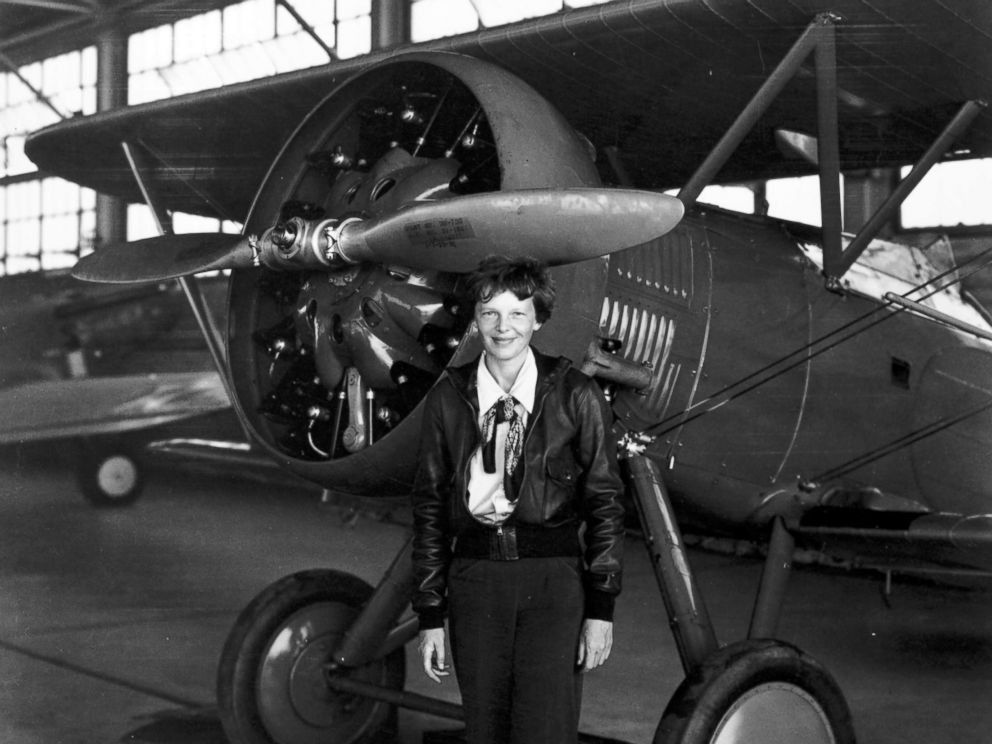
In 1937, the world watched and waited as
Amelia Earhart attempted to become the first female pilot to fly around the
world. When Earhart and her navigator, Fred Noonan, mysteriously disappeared
somewhere in the Pacific Ocean, the world anxiously awaited answers, but
Earhart and Noonan were never found (“Amelia Earhart”). Several conspiracy
theories have developed to try and solve this age old mystery. Did Earhart crash and drown somewhere in the
Pacific Ocean? Did Earhart land on the wrong island? Was Earhart captured and
taken prisoner by the Japanese? Throughout this paper, the above conspiracy
theories will be discussed.
When
most people hear the name Amelia Earhart, they immediately think, “woman pilot
who disappeared”. But, to those who personally knew Amelia Earhart, they would
say that she was so much more than a pilot. Her passionate dreams, independent
spirit, and push for equality in the world of aviation, shaped her as a person
and made her disappearance even more devastating.
Amelia Earhart was a passionate
dreamer. While Earhart was attending a junior college, she visited her sister
and discovered that she had a heart for caring for injured soldiers (The
Editors of Encyclopedia Briticana 1). Earhart left her junior college and
followed her passion by helping wounded World War 1 soldiers in Toronto,
Canada. In 1920, Earhart experienced her first taste of flying (The Editors of
Encyclopedia Briticana 1). After her short, first flight, Earhart said, “As
soon as I left the ground, I myself knew that I had to fly (Hilton 1).” Less
than a year after Earhart’s first flight, she began taking flying lessons and
bought her own personal plane, a Kinner Airster. Two years later, Amelia
Earhart had received her pilot’s license (The Editors of Encyclopedia Briticana
1). These steps of buying a plane and receiving her pilot license ignited
Earhart’s dream to fly.
Amelia Earhart had a driven,
independent spirit. During Earhart’s early life, her family moved frequently.
Her family described Earhart as having an independent and adventurous spirit
despite being moved from place to place (Cochrane 1). As a child, Earhart kept
a scrapbook of influential women in history that she looked up to, and in high
school, Earhart was one of the only girls to take an auto repair class
(Cochrane 1). Even as an adult, Earhart was afraid to be tied down. Earhart
commented on marriage saying, “Why should marriage be a cyclone cellar into
which a woman retreats from failures in other spheres? I can think of lots of
things worse than never getting married. One of the worst is being married to a
man who tied you down (Ware 13)”. Earhart met George Putnam after her first
transatlantic passenger flight, and he became her publicist and manager. Putnam
proposed six times before Earhart said yes with three conditions (Bernikow 1).
First, she told Putnam that she would not hold either one of them to a code of
faithfulness. Second, she refused to stop flying after they were married.
Third, she was not promising that she would stay married to him. Earhart told
Putnam that if she was not happy after a year, then she would leave with no
strings attached. Despite these conditions, Earhart married George Putnam in
1931 (Bernikow 1). Just as Earhart rejected the idea of not flying, she refused
to let go of her independent spirit.
Amelia Earhart was an inspiration to
other women. Almost all of Earhart’s accomplishments revolved around her
setting records in women’s flying history. In 1922, she set the highest
altitude record of 14,000 feet for women pilots (Achievements 1). In 1929,
Earhart participated and placed third in the All-Women’s Air Derby
(Achievements 1). After the Derby, a few of the women pilots organized a group
to encourage female pilots, socially and economically in the midst of a society
with a lack of independence for women. They called themselves the Ninety Nine
because ninety-nine out of 285 licensed women pilots joined the group (Cochrane
1). Amelia Earhart served as the Ninety Nine’s first president. Earhart also
became the first woman to fly alone and non-stop across the Atlantic Ocean in
1932 (Cochrane 1). Earhart served as the first female Vice President of the
National Aeronautic Association. During her time as Vice President of this
organization, she convinced them to separate female pilot’s flight records from
the men’s, saying that women could not fairly compete with men for world titles
due to lack of money, resources, and experience (Cochrane 1). Earhart
campaigned tirelessly for women’s rights in the flying world. She even designed
a clothing and luggage line to promote the active woman that included
functional dresses, pants, suits, and lightweight luggage. In 1935, Earhart
occasionally spoke as a visiting professor on the subject of furthering women’s
education at Purdue University (Cochrane 1). Whether it be promoting women’s
flight safety to Congress, lecturing on women’s advancements in flying, or
writing articles for numerous magazines, Earhart was dedicated to informing the
public on key issues in the world of aviation for women (Cochrane 1).
Since Amelia Earhart was such an
inspirational and prominent woman of history, the world grieved deeply when she
mysteriously disappeared during her attempt to fly around the world in 1937.
How could someone who was so independent and knowledgeable about planes, not
realize that something was wrong with her own plane, unless, Amelia Earhart’s
plane never went down in the Pacific Ocean?
There are many conspiracy theories
surrounding the disappearance of Amelia Earhart, but there are three that seem
the most plausible. The first two conspiracy theories involve Earhart’s plane
going down in the Pacific Ocean or on an island. The other theory suggests that
Earhart and her navigator were taken prisoner by the Japanese (Shea 1).
The first conspiracy
theory and usually the most popular suggests that Amelia Earhart’s plane
crashed in the Pacific Ocean due to low fuel. This theory is backed up by the
fact that Earhart and her navigator, Fred Noonan, sent in multiple calls to the
Coast Guard saying that they were low on fuel (Shea 1). Earhart and Noonan left
Lae, Papua New Guinea,
heading for Howland Island. A Coast Guard boat was waiting at Howland Island
for Earhart (Shea 1). The boat reported that they heard a message from Earhart
saying, “We must be on you, but cannot see you — but gas is running low. Have
been unable to reach you by radio. We are flying at 1,000 feet (Lorenzi 1).”
After that message, Earhart and Noonan supposedly ran out of fuel and crashed
in the Pacific Ocean. Doubts still surround this theory, though,
because, despite the fact that years were spent searching in an effort to find
the plane, no traces of the wreckage were ever found (Ryerson 1). Many searches
have been led, taking into account fuel levels and radio transmission signals,
but no remains of the crash have been discovered (Ryerson 1). This theory makes
the most logical sense, but there is still the mystery of the wreckage.
The second
theory suggests that Earhart and Noonan landed on an island in the Pacific and eventually
died as castaways. When Earhart and Noonan could not find Howland Island, they
instead landed on Nikumaroro Island, 350 miles away from Howland Island, where
they died from lack of resources (Shea 1). This theory is backed up by the fact
that Earhart’s last radio message said, “line 157 337.” Researchers confirmed
that this coordinate showed Earhart’s plane was flying in the direction of
Nikumaroro Island (Ryerson 1). Also, multiple people reported hearing radio
messages from Amelia Earhart. Over the next ten days after Earhart’s plane
crashed, fifty-seven radio messages were heard that sounded like distress calls
from Earhart and Noonan (Hale 1). Researchers studied these messages and
discovered that the times of the messages lined up with when the tide would
have been low on the island of Nikumaroro, allowing Earhart and Noonan to make
calls from their plane. One person from Ashland, Kentucky, received a radio
message saying, “Our plane
about out of gas. Water all around. Very dark. Will have to get out of here. We
can’t stay (Hale 1).” The radio messages
ceased on July 13, 1937. Other evidence that backs up the island landing theory
is the possible remnants of the crash on the island (Ryerson 1). A British
group explored Nikumaroro Island in 1937 hoping to start a community on the
island. One of the group members, Eric Bevington, took pictures around the
island and noticed an object that resembled airplane landing gear along the
shoreline (Ryerson 1). After the island was colonized, the settlers reported
finding parts of an airplane that could have been the same model as Earhart’s
plane. The leader of the settlers on Nikumaroro Island found thirteen bones
beside the remnants of a fire (Ryerson 1). After the bones were evaluated, the
results showed that it was plausible that they belonged to a female around the
same build as Amelia Earhart. Along with the bones, the settlers also found a
man’s shoe, a woman’s shoe, and a navigational device like Earhart had used
(Ryerson 1). The International Group for Historical Airplane Recovery led
several trips back to Nikumaroro Island looking for more clues from Earhart’s
plane. They found evidence of fires and remains of fish, birds, clams, and
turtles (Ryerson 1). Based on the way that the animals were eaten, it did not
seem to be the work of a native islander. They also found what seemed to be a
bottle of freckle cream, probably used by Earhart herself (Ryerson 1). A
substantial amount of physical evidence has been found to support this theory.
The last theory explores the idea that Earhart and Noonan
were captured by the Japanese and executed. When Earhart and Noonan could not
find Howland Island, they mistakenly or purposefully landed on Marshall Island,
which was controlled by the Japanese (Shea 1). Thinking that Earhart and Noonan
were American spies, the Japanese took them hostage and later executed them
(Shea 1). This theory is backed up by evidence of a photograph and witness
testimony (Ryerson 1). A documentary was created called Amelia Earhart: The Lost Evidence, where it was revealed that a
picture has been found in the National Archives of Earhart and Noonan sitting
on a dock at one of the Marshall Islands, Jaluit Atoll (Shea 1). Also, an
Earhart admirer, Dick Spink, visited the Marshall Islands and interviewed many
of the islanders that might remember if Earhart and Noonan had been on the
island. “The world needs to know this,” Spink said after interviewing the
Islanders (Ryerson 1). “I heard a consistent story from too many people in the
Marshalls to dismiss it. They say, ‘She landed at Mili. Our uncles and aunts,
our parents, and our grandparents know she landed here (Ryerson 1).’ ” Although
there is some evidence to prove this theory, scientists would argue that it was
impossible for the plane to reach the Marshall Islands. Fred Patterson, a pilot
of the same model plane as Earhart, said, “There’s just no way she made it to
the Marshall Islands. I’ve done some long-range flying in that airplane myself,
and I know exactly what it burns per hour (Ryerson 1).” While this conspiracy
theory has some evidence going for it, there is also substantial evidence
refuting this theory.
All three of these conspiracy theories have evidence to
back them up and disproofs to pull them down. Based on a survey conducted on
twenty-five people, Sixty-eight percent concluded that she crashed her plane
into the Pacific Ocean. Sixteen percent
thought that she landed on an island and died as a castaway, and sixteen
percent said that she was kidnapped by the Japanese (Creech 1). While most
people agree that Amelia Earhart’s plane crashed in the Pacific Ocean, the only
way to truly solve this age-old mystery is to find the wreckage of Earhart’s
plane.
While people have constructed
numerous conclusions as to how Amelia Earhart and Fred Noonan disappeared,
there are three theories that sound the most reasonable:
1. Did Earhart crash and drown
somewhere in the Pacific Ocean?
2. Did Earhart land on the wrong
island?
3. Was Earhart captured and taken
prisoner by the Japanese?
The official report still holds to
the fact that Earhart’s plane crashed in the Pacific Ocean. Until the wreckage
of their plane is found, the world will await answers to this mysterious
disappearance.
Work
Cited
“Achievements - The Official Licensing
Website of Amelia Earhart.” Amelia
Earhart,
Bernikow, Louise. “Amelia Earhart
Marries George Palmer Putnam.” Women's
ENews, Red
Wheel/Weiser, LLC., 17 Sept. 2009,
womensenews.org/2003/06/amelia-earhart-marries-george-palmer-putnam/.
Britannica, The Editors of
Encyclopaedia. “Amelia Earhart.” Encyclopædia
Britannica,
Encyclopædia Britannica, Inc., 20
July 2018, www.britannica.com/biography/Amelia-Earhart.
Cochrane, D. “Women in Aviation and
Space History - Smithsonian National Air and Space
Museum.” National Air and Space Museum,
airandspace.si.edu/explore-and-learn/topics/women-in-aviation/earhart.cfm.
Creech,
Autumn. How Do You Think Amelia Earhart
Died?,
ZDJ_2F7k_3D.
Hale,
Tom. “Amelia Earhart's Haunting Last Radio Calls Could Explain Her Mysterious
Disappearance.” IFLScience,
IFLScience, 18 Aug. 2018,
www.iflscience.com/editors-blog/amelia-earharts-haunting-last-radio-calls-could-explain-her-mysterious-disappearance/.
Hilton, Barron. “Amelia Earhart.” Bessie Coleman | Pioneers of Flight,
pioneersofflight.si.edu/content/amelia-earhart-0.
History Editors. “‘Amelia Earhart.’”
History.com, A&E Television
Networks, 2009,
Lorenzi,
Rossella. “Credible Amelia Earhart Radio Signals Were Ignored as Bogus.”
NBCNews.com, NBCUniversal News Group, 1 June 2012,
arhart-radio-signals-were-ignored-bogus/#.W9b_xtdKiM8.
Ryerson,
Lia. “5 Of the Wildest Conspiracy Theories behind Amelia Earhart's
Disappearance.”
Business
Insider, Business Insider, 9 May
2018,
#3-she-was-captured-and-taken-prisoner-by-the-japanese-3.
Shea,
Rachel. “Top 3 Theories for Amelia Earhart's Disappearance.” National Geographic,
National Geographic
Society, 11 July 2017,
news.nationalgeographic.com/2017/07/amelia-earhart-disappearance-theories-spd/.
Ware, Susan. Still Missing: Amelia Earhart and the Search for Modern Feminism.
Norton, 1995.



No comments:
Post a Comment